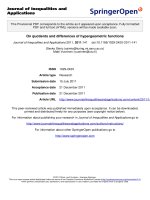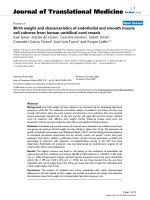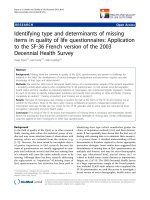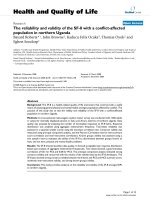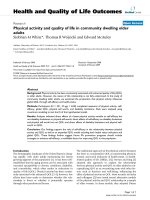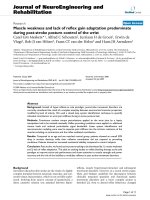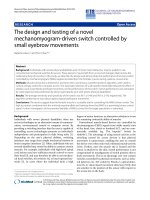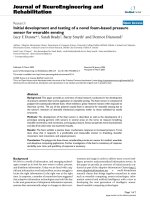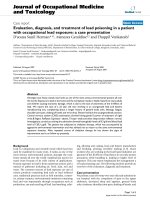báo cáo hóa học:"On quotients and differences of hypergeometric functions" pptx
Bạn đang xem bản rút gọn của tài liệu. Xem và tải ngay bản đầy đủ của tài liệu tại đây (233.4 KB, 17 trang )
This Provisional PDF corresponds to the article as it appeared upon acceptance. Fully formatted
PDF and full text (HTML) versions will be made available soon.
On quotients and differences of hypergeometric functions
Journal of Inequalities and Applications 2011, 2011:141 doi:10.1186/1029-242X-2011-141
Slavko Simic ()
Matti Vuorinen ()
ISSN 1029-242X
Article type Research
Submission date 15 July 2011
Acceptance date 21 December 2011
Publication date 21 December 2011
Article URL />This peer-reviewed article was published immediately upon acceptance. It can be downloaded,
printed and distributed freely for any purposes (see copyright notice below).
For information about publishing your research in Journal of Inequalities and Applications go to
/>For information about other SpringerOpen publications go to
Journal of Inequalities and
Applications
© 2011 Simic and Vuorinen ; licensee Springer.
This is an open access article distributed under the terms of the Creative Commons Attribution License ( />which permits unrestricted use, distribution, and reproduction in any medium, provided the original work is properly cited.
On quotients and differences of hypergeometric functions
Slavko Simi´c
∗1
and Matti Vuorinen
2
1
Mathematical Institute SANU, Kneza Mihaila 36, 11000 Belgrade, Serbia
2
Department of Mathematics, University of Turku, 20014 Turku, Finland
*Corresponding author:
Email address:
MV: vuorinen@utu.fi
Abstract For Gaussian hypergeometric functions F(x) = F(a, b; c; x), a,b, c > 0, we
consider the quotient Q
F
(x, y) = (F (x) + F(y))/F(z) and the difference D
F
(x, y) =
F (x) + F (y) − F (z) for 0 < x, y < 1 with z = x + y − xy. We give best possible bounds
for both expressions under various hypotheses about the parameter triple (a, b; c).
2010 Mathematics Subject Classification: 26D06; 33C05.
Keywords: sub-additivity; hypergeometric functions; inequalities.
1. Introduction
Among special functions, the hypergeometric function has perhaps the widest range
of applications. For instance, several well-known classes of special functions such as
complete elliptic integrals, Legendre functions, Chebyshev and Jacobi polynomials, and
some elementary functions, such as the logarithm, are particular cases of it, cf. [1]. In
a recent article [2] the authors studied various extensions of the Bernoulli inequality for
functions of logarithmic type. In particular, the zero-balanced hypergeometric function
F (a, b; a + b; x), a, b > 0 occurs in these studies, because it has a logarithmic singularity
at x = 1, see (2.8) below. We now continue the discussion of some of the questions for
quotients and differences of hypergeometric functions that were left open in [2].
1
2
Motivated by the asymptotic behavior of the function F (x) = F (a, b; c; x) when x → 1
−
,
see (2.8), we define for 0 < x, y < 1, a, b, c > 0
(1.1) Q
F
(x, y) :=
F (x) + F(y)
F (x + y −xy)
, D
F
(x, y) := F (x) + F(y) −F (x + y −xy).
Our task in this article is to give tight bounds for these quotients and differences
assuming various relationships between the parameters a, b, c.
For the general case, we can formulate the following theorem.
Theorem 1.2. For a, b, c > 0 and 0 < x, y < 1 let Q
F
be as in (1.1). Then,
(1.3) 0 < Q
F
(x, y) ≤ 2.
The bounds in (1.3) are best possible as can be seen by taking [1, 15.1.8]
F (x) = F(a, b; b; x) = (1 − x)
−a
:= F
0
(x).
Then,
Q
F
0
(x, y) =
(1 −x)
−a
+ (1 − y)
−a
(1 −x −y + xy)
−a
=
(1 −x)
−a
+ (1 − y)
−a
((1 −x)(1 −y))
−a
= (1 −x)
a
+ (1 −y)
a
,
and the conclusion follows immediately. Similarly,
Theorem 1.4. For a, b > 0, c > a + b and 0 < x, y < 1, we have
(1.5) |D
F
(x, y)| ≤ A,
with A = A(a, b, c) =
Γ(c)Γ(c−a−b)
Γ(c−a)Γ(c−b)
= F (a, b; c; 1) as the best possible constant.
Most intriguing is the zero-balanced case. For example,
3
Theorem 1.6. For a, b > 0 and 0 < x, y < 1 let D
F
be as in (1.1). Then,
(1.7)
R
B
< D
F
(x, y) < 1
with R = R(a, b) = −2γ − ψ(a) − ψ(b), B = B(a, b).
Both bounding constants are best possible.
In the sequel, we shall give a complete answer to an open question posed in [2].
2. Preliminary results
In this section, we recall some well-known properties of the Gaussian hypergeometric
function F(a, b; c; x) and certain of its combinations with other functions, for further
applications.
It is well known that hypergeometric functions are closely related to the classical gamma
function Γ(x), the psi function ψ(x), and the beta function B(x, y). For Re x > 0, Re y > 0,
these functions are defined by
(2.1) Γ(x) ≡
∞
0
e
−t
t
x−1
dt, ψ(x) ≡
Γ
(x)
Γ(x)
, B(x, y) ≡
Γ(x)Γ(y)
Γ(x + y)
,
respectively (cf. [1, Chap. 6]). It is well known that the gamma function satisfies the
difference equation [1, 6.1.15]
(2.2) Γ(x + 1) = xΓ(x),
and the reflection property [1, 6.1.17]
(2.3) Γ(x)Γ(1 −x) =
π
sin πx
= B(x, 1 −x).
4
We shall also need the function
(2.4) R(a, b)≡−2γ−ψ(a)−ψ(b), R(a)≡R(a, 1−a), R
1
2
=log 16,
where γ is the Euler-Mascheroni constant given by
(2.5) γ = lim
n→∞
n
k=1
1
k
− log n
= 0.577215 . . . .
Given complex numbers a, b, and c with c = 0, −1, −2, . . ., the Gaussian hypergeometric
function is the analytic continuation to the slit plane C \[1, ∞) of the series
(2.6) F (a, b; c; z) =
2
F
1
(a, b; c; z) =
∞
n=0
(a, n)(b, n)
(c, n)
z
n
n!
, |z| < 1.
Here (a, 0) = 1 for a = 0, and (a, n ) is the shifted factorial function or the Appell symbol
(a, n) = a(a + 1)(a + 2) ···(a + n − 1)
for n ∈ N \{0}, where N = {0, 1, 2, . . .}.
The hypergeometric function has the following simple differentiation formula ([1, 15.2.1])
(2.7)
d
dx
F (a, b; c; x) =
ab
c
F (a + 1, b + 1; c + 1; x).
An important tool for our study is the following classification of the behavior of the
hypergeometric function near x = 1 in the three cases a + b < c, a + b = c, and a + b > c :
(2.8)
F (a, b; c; 1) =
Γ(c)Γ(c −a −b)
Γ(c −a)Γ(c −b)
, a + b < c,
B(a, b)F (a, b; a+b; x)+log(1−x)=R(a, b)+O((1−x) log(1−x)),
F (a, b; c; x) = (1−x)
c−a−b
F (c−a, c−b; c; x), c < a+b.
Some basic properties of this series may be found in standard handbooks, see for ex-
ample [1]. For some rational triples (a, b, c), the functions F (a, b; c; x) can be expressed
5
in terms of well-known elementary function. A particular case that is often used in this
article is [1, 15.1.3]
(2.9) g(x) ≡ xF (1, 1; 2; x) = log
1
1 −x
.
It is clear that for a, b, c > 0 the function F(a, b; c; x) is a strictly increasing map from
[0, 1) into [1, ∞) and that by (2.8) we see that it is onto [1, ∞) if a + b ≥ c. For a, b > 0
we see by (2.8) that xF (a, b; a + b; x) defines an increasing homeomorphism from [0 , 1)
onto [0
,
∞
)
.
Theorem 2.10. [3],[4, Theorem 1.52] For a, b > 0, let B = B(a, b) be as in (2.1), and let
R = R(a, b) be as in (2.4). Then the following are true.
(1) The function f
1
(x) ≡
F (a,b;a+b;x)−1
log(1/(1−x))
is strictly increasing from (0, 1) onto
(ab/(a + b), 1/B).
(2) The function f
2
(x) ≡ BF(a, b; a+b; x)+log(1−x) is strictly decreasing from (0, 1)
onto (R, B).
(3) The function f
3
(x) ≡ BF(a, b; a + b; x) + (1/x) log(1 −x) is increasing from (0, 1)
onto (B − 1, R) if a, b ∈ (0, 1).
(4) The function f
3
is decreasing from (0, 1) onto (R, B −1) if a, b ∈ (1, ∞) .
(5) The function
f
4
(x) ≡
xF (a, b; a + b; x)
log(1/(1 −x))
is decreasing from (0, 1) onto (1/B, 1) if a, b ∈ (0, 1).
(6) If a, b > 1, then f
4
is increasing from (0, 1) onto (1, 1/B).
(7) If a = b = 1, then f
4
(x) = 1 for all x ∈ (0, 1).
We also need the following refinement of some parts of Theorem 2.10.
6
Lemma 2.11. [5, Cor. 2.14] For a, b > 0, let B = B(a, b) be as in (2.1), and let
R = R(a, b) be as in (2.4) and denote
f(x) ≡
xF (a, b; a + b; x)
log(1/(1 −x))
.
(1) If a ∈ (0, ∞) and b ∈ (0, 1/a], then the function f is decreasing with range (1/B, 1);
(2) If a ∈ (1/2, ∞) and b ≥ a/(2a − 1), then f is increasing from (0, 1) to the range
(1, 1/B).
(3) If a ∈ (0, ∞) and b ∈ (0, 1/a], then the function h defined by
h(x) := BF(a, b; a + b; x) + (1/x) log(1 −x)
is increasing from (0, 1) onto (B − 1, R).
(4) If a ∈ (1/3, ∞) and b ≥ (1 + a)/(3a − 1), then h is increasing from (0, 1) onto
(R, B − 1).
For brevity, we write R
+
= (0, ∞).
Lemma 2.12. (Cf. [4, 1.24, 7.42(1)]) (1) If E(t)/t is an increasing function on R
+
, then
E is sub-additive, i.e., for each x, y > 0 we have that
E(x) + E(y) ≤ E(x + y).
(2) If E(t)/t decreases on R
+
, then E is a super-additive function, that is
E(x) + E(y) ≥ E(x + y)
for x, y ∈ R
+
.
7
3. Main results
By (2.8), the zero-balanced hypergeometric function F (a, b; a + b; x) has a logarithmic
singularity at x = 1. We shall now demonstrate that its behavior is nearly logarithmic
also in the sense that some basic identities of the logarithm yield functional inequalities
for the zero-balanced function.
Next, writing the basic addition formula for the logarithm
log z + log w = log(zw), z, w > 0,
in terms of the function g in (2.9), we have
g(x) + g(y) = g(x + y −xy), x, y ∈ (0, 1).
Based on this observation and a few computer experiments, we posed in [2] the following
question:
Question 3.1. Fix c, d > 0 and let g(x) = xF (c, d; c + d; x) for x ∈ (0, 1) and set
Q
g
(x, y) =
g(x) + g(y)
g(x + y − xy)
for x, y ∈ (0, 1).
(1) For which values of c and d, this function is bounded from below and above?
(2) Is it true that
a) Q
g
(x, y) ≥ 1, if cd ≤ 1?
b) Q
g
(x, y) ≤ 1, if c, d > 1?
c) Are there counterparts of Theorem 1.6 for the function
D
g
(x, y) = g(x) + g(y) − g(x + y − xy)?
8
We shall give a complete answer to this question in the sequel.
Note first that the quotient Q
g
is always bounded. Namely,
Theorem 3.2. For all c, d > 0 and all x, y ∈ (0, 1) we have that
0 < Q
g
(x, y) < 2.
A refinement of these bounds for some particular (c, d) pairs is given by the following
two assertions.
Theorem 3.3. (1) For c, d > 0, cd ≤ 1 and x, y ∈ (0, 1) we have
1
B(c, d)
≤ Q
g
(x, y) ≤ B(c, d).
(2) For c, d > 0, 1/c + 1/d ≤ 2 and x, y ∈ (0, 1) we have
B(c, d) ≤ Q
g
(x, y) ≤
1
B(c, d)
.
Note that parts (1) and (3) of Lemma 2.11 imply that for c, d > 0, cd ≤ 1, (c, d) = (1, 1)
we have
(3.4) R(c, d) > 0, B(c, d) > 1.
Theorem 3.5. For cd ≤ 1 and x, y ∈ (0, 1) we have
B(c, d) −1
R(c, d)
≤ Q
g
(x, y) ≤
2R(c, d)
B(c, d) −1
.
We shall prove now the hypothesis from the second part of Question 3.1 under the
condition 1/c + 1/d ≤ 2 in part (b) which, in particular, includes the case c > 1, d > 1.
Theorem 3.6. Fix c, d > 0 and let Q and g be as in Question 3.1.
(1) If cd ≤ 1 then Q
g
(x, y) ≥ 1 for all x, y ∈ (0, 1).
9
(2) If 1/c + 1/d ≤ 2, then Q
g
(x, y) ≤ 1 for all x, y ∈ (0, 1).
Counterparts of Theorem 1.6 for the difference D
g
are given in the next assertion.
Theorem 3.7. Fix c, d > 0 and let D be as in Question 3.1.
(1) If cd ≤ 1, then
0 ≤ D
g
(x, y) <
2R(c, d) + 1
B(c, d)
− 1
for all x, y ∈ (0, 1).
(2) If 1/c + 1/d ≤ 2, then
2R(c, d) + 1
B(c, d)
− 1 < D
g
(x, y) ≤ 0
for all x, y ∈ (0, 1).
Combining the results ab ove, we obtain the following two-sided bounds for the quotient
Q
g
.
Corollary 3.8. Fix c, d > 0 and let Q be as in Question 3.1.
(1) If cd ≤ 1, then
1 ≤ Q
g
(x, y) < min{B(c, d), 2}
for all x, y ∈ (0, 1).
(2) If 1/c + 1/d ≤ 2, then
B(c, d) < Q
g
(x, y) ≤ 1
for all x, y ∈ (0, 1).
10
The assertions above represent a valuable tool for estimating quotients and differences
of a hypergeometric function with different arguments. To illustrate this point, we give
an example.
In [2], motivated by the relation g(x) = 2g(1 −
√
1 −x) with g as in (2.9), the authors
asked the question about the bounds for the function S(t) defined by
S(t) :=
g(t)
g(1 −
√
1 −t)
, t ∈ (0, 1),
where g(t) := tF (a, b; a + b; t), a, b > 0.
An answer follows instantly applying Corollary 3.8.
Theorem 3.9. Let S(t) :=
g(t)
g(1−
√
1−t)
, t ∈ (0, 1), with g(t) := tF (a, b; a + b; t), a, b > 0.
(1) If ab ≤ 1, then
1 < S(t) ≤ 2.
(2) If 1/a + 1/b ≤ 2, then
2 ≤ S(t) <
2
B(a, b)
.
4. Proofs
4.1. Proof of Theorem 1.2.
The proof is based solely on the monotonicity property of the function F (x) = F(a, b; c; x).
Namely, for x, y ∈ (0, 1), put z = x + y − xy, z ∈ (0, 1). Since
x ≤ max{x, y}, y ≤ max{x, y}; z ≥ max{x, y},
and F (u) is monotone increasing in u, we obtain
Q
F
(x, y) =
F (x) + F(y)
F (z)
≤
2F (max{x, y})
F (max{x, y})
= 2.
The left-hand bound is trivial.
11
4.2. Proof of Theorem 1.4.
The assertion of this theorem is a consequence of the previous one and (2.8). Indeed,
from (1.3) we get
−F (a, b; c; z) < D
F
(x, y) ≤ F (a, b; c; z),
that is,
|D
F
(x, y)| ≤ F (a, b; c; z) = F (a, b; c; 1 −(1 −x)(1 −y)) ≤ F (a, b; c; 1) = A.
4.3. Proof of Theorem 1.6.
Consider the function
s(x) = F (a, b, a + b; x) − F(a, b, a + b; x + y − xy),
where y, y ∈ (0, 1), is an independent parameter.
Since
s
(x) = F
(a, b, a + b; x) −(1 −y)F
(a, b, a + b; x + y − xy)
=
ab
a + b
(F (a + 1, b + 1, a + b + 1; x) −(1 −y)F (a + 1, b + 1, a + b + 1; x + y − xy)),
we get (1 −x)s
(x)
=
ab
a + b
((1−x)F (a+1 , b+1, a+b+1; x)−(1−x)(1−y)F (a+1 , b+1, a+b+1; x+y −xy))
=
ab
a + b
(F (a, b, a + b + 1; x) − F(a, b, a + b + 1; x + y −xy)) < 0.
Therefore, s(x) is monotone decreasing on (0, 1) and, consequently,
s(x) < lim
x→0
+
s(x) = 1 −F (a, b, a + b; y).
Also, by Theorem 2.10, part 2, we obtain
12
s(x) > lim
x→1
−
s(x) =
1
B
log(1 −y) >
R
B
− F(a, b, a + b; y).
Since D
F
(0
+
, 0
+
) = 1 and D
F
(1
−
, 1
−
) = R/B, cited bounds are best possible.
4.4. Proof of Theorem 3.2.
Analogously to the proof of Theorem 1.2, we have
Q
g
(x, y) =
xF (x) + yF (y)
zF (z)
≤
(x + y)F (max{x, y})
zF (max{x, y})
=
x + y
z
< 2.
4.5. Proof of Theorem 3.3.
Lemma 2.11 (1) yields
1
B
log(1/(1 −u)) ≤ uF (u) ≤ log(1/(1 −u)),
for u ∈ (0, 1), cd ≤ 1.
Therefore,
xF (x) + yF (y)
(x + y − xy) F (x + y −xy)
≤
log
1
1−x
+ log
1
1−y
1
B
log
1
(1−x)(1−y)
= B(c, d).
The lower bound is proved in the same way.
Applying part (2) of Lemma 2.11, we bound Q
g
similarly in the case 1/c + 1/d ≤ 2.
Remark 4.1. From parts (1) and (3) of Lemma 2.11, we conclude that
R(c, d) > B(c, d) −1 > 0,
for c, d > 0, cd ≤ 1, (c, d) = (1, 1).
13
4.6. Proof of Theorem 3.4.
Let us write B = B(c, d), R = R(c, d) and L = log (1 /((1 − x)(1 − y))) > 0. By Lemma
2.11 (3) we have
(4.2)
B − 1
B
x +
1
B
log
1
1 −x
< xF (c, d; c + d; x) <
Rx
B
+
1
B
log
1
1 −x
.
Since x + y < 2(x + y −xy) we obtain by (4.2)
Q
g
(x, y) ≤
R(x+y)
B
+
L
B
B−1
B
(x + y − xy) +
L
B
≤
2R(x + y − xy) + L
(B − 1)(x + y − xy) + L
≤
2R
B − 1
,
and
Q
g
(x, y) ≥
(B − 1)(x + y) + L
R(x + y − xy) + L
≥
(B − 1)(x + y − xy) + L
R(x + y − xy) + L
≥
B − 1
R
.
4.7. Proof of Theorem 3.6.
By the first part of Lemma 2.11, f is monotone decreasing for cd ≤ 1.
Hence, for 0 < x < y < 1 we have
xF (c, d; c + d; x)
log(1/(1 −x))
≥
yF (c, d; c + d; y)
log(1/(1 −y))
.
Putting 1 −x = e
−u
, 1 −y = e
−v
; u, v ∈ (0, ∞), we get that the inequality
(1 −e
−u
)F (c, d; c + d; (1 − e
−u
))
u
≥
(1 −e
−v
)F (c, d; c + d; (1 − e
−v
))
v
holds whenever 0 < u < v < ∞.
This means that the function G(t)/t is monotone decreasing, where
G(t) := (1 −e
−t
)F (c, d; c + d; (1 − e
−t
)) = g(1 −e
−t
).
By Lemma 2.12, it follows that G is super-additive, that is
G(u) + G(v) ≥ G(u + v),
14
which is equivalent to
g(x) + g(y) ≥ g(x + y −xy),
and the proof of the first part of Theorem 3.6 is complete.
The proof of the second part is similar. Note that the condition c ∈ (1/2, ∞), d ≥
c/(2c −1) of Lemma 2.11 is equivalent to the condition 1/c + 1/d ≤ 2 of Theorem 3.6.
4.8. Proof of Theorem 3.7.
(1) The left-hand side of this inequality is a direct consequence of part (1) of Theorem
3.6.
Next, from Lemma 2.11, part (3) for u ∈ (0, 1), cd ≤ 1, we get
(B − 1)u −log(1 −u) < BuF(u) < Ru −log(1 −u).
Hence, by the terminology from Theorem 3.2, we obtain
BD
g
(x, y) = BxF(x)+ByF (y)−BzF (z) < log(1−z)−log(1−x)−log(1−y)+R(x+y)−(B−1)z
= (R −B + 1)(x + y) + (B − 1)xy < 2(R −B + 1) + (B −1) = 2R + 1 −B,
since Remark 4.1 yields R −B + 1 > 0 and B − 1 > 0.
(2) To prove this part we shall use Lemma 2.11, part (4). Because d ≥ c/(2c − 1) ≥
(c + 1)/(3c − 1) and (1/2, ∞) ⊂ (1/3, ∞), we conclude that this assertion is valid under
the condition 1/c + 1/d ≤ 2.
Therefore, for u ∈ (0, 1), 1/c + 1/d ≤ 2, (c, d) = (1, 1), we get
Ru −log(1 −u) < BuF(u) < (B −1)u −log(1 −u),
and, as above,
BD
g
(x, y) = BxF(x)+ByF (y)−BzF (z) > log(1−z)−log(1−x)−log(1−y)+R(x+y)−(B−1)z
15
= (R −B + 1)(x + y) + (B − 1)xy > 2(R −B + 1) + (B −1) = 2R + 1 −B,
since parts (1) and (4) of Lemma 2.11 give R −B + 1 < 0 and B − 1 < 0.
Because the right-hand inequality is a consequence of Theorem 3.6, part (2), the proof
is complete.
4.9. Proof of Theorem 3.9.
Putting x = y = 1 −
√
1 −t, we obtain z = x + y − xy = t. Therefore,
Q
g
(x, y) = 2/S(t).
The rest is an application of Corollary 3.8.
Competing interests
The authors declare that they have no competing interests.
Authors’ contributions
Some of the main problems in this paper were motivated by earlier work and computer
experiments of MV. SS found most proofs. All authors read and approved the final
manuscript.
Acknowledgments
The authors are indebted to the referee for his/her constructive comments. The research
of Matti Vuorinen was supported by the Academy of Finland, Project 2600066611. This
project also supported Slavko Simi´c’ visit to Finland.
(2011)
Abramowitz, M, Stegun, IA (eds.): Handbook of Mathematical Functions with Formulas, Graphs
16
References
[1]
and Mathematical Tables. Dover, New York (1965)
[2] Kl´en, R, Manojlovi´c, V, Simi´c, S, Vuorinen, M: Bernoulli inequality and hypergeometric functions,
15 pp. arXiv math.CA 1106.1768
[3] Anderson, GD, Barnard, RW, Richards, KC, Vamanamurthy, MK, Vuorinen, M: Inequalities for
zero-balanced hypergeometric functions. Trans. Am. Math. Soc. 347, 1713–1723 (1995)
[4] Anderson, GD, Vamanamurthy, MK, Vuorinen, M: Conformal Invariants, Inequalities and Quasi-
conformal Maps. John Wiley & Sons, New York (1997)
[5] Ponnusamy, S, Vuorinen, M: Asymptotic expansions and inequalities for hypergeometric functions.
Mathematika 44, 278–301 (1997)
